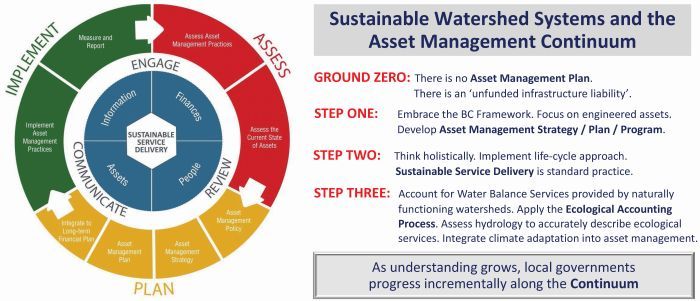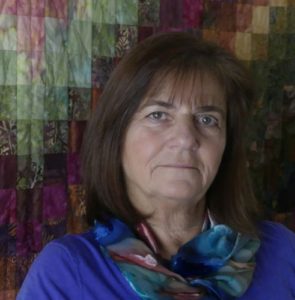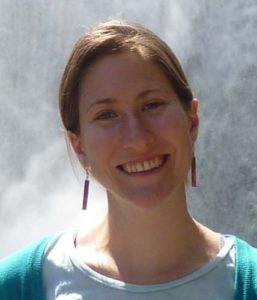NANAIMO WATER SYMPOSIUM: Watershed Stewardship in a Changing Environment – Collaboration Success Stories (April 11-12, 2018)
Note to Reader:
The rhythms of water are changing in British Columbia – winters are wetter and warmer; summers are longer and drier. In short, the water cycle is out of balance. Why is this? The answer is that warming of the planet’s atmosphere is causing water to move more quickly and disruptively through the global water cycle. Local consequences are magnified.
Adapting to climate change requires transformation in how we perceive watershed worth and service land. The Nanaimo Water Symposium is designed to foster a conversation in the mid-Vancouver Island region and beyond about the transformational scope of the “Sustainable Watershed Systems, through Asset Management” program. The symposium is an outreach and professional development event, held under the umbrella of the Georgia Basin Inter-Regional Education Initiative.
On April 11-12, 2018, join us at the Coast Bastion hotel in Nanaimo to learn about three initiatives in particular: (1) the good things that flow from local government and stewardship sector collaboration; (2) the over-arching role played by the innovative and precedent-setting Drinking Water & Watershed Protection Program in the Regional District of Nanaimo; and, (3) the first demonstration applications of the Ecological Accounting Process (EAP) to assess “watershed worth”.
Download a copy of the PROGRAM BROCHURE
To register, visit https://www.civicinfo.bc.ca/event/2018/Nanaimo-Water-Symposium

THE HARD WORK OF HOPE – Water Stewardship in a Changing Climate (Field Trip, Public Lecture & Symposium in Nanaimo)
The “Sustainable Watershed Systems, through Asset Management” program is aligned with the vision forAsset Management for Sustainable Service Delivery: A BC Framework, released by the government of BC and UBCM in 2015.
The BC Framework goes to the heart of what local government does on an everyday basis. The BC Framework sets a strategic direction that refocuses business processes on outcomes that reduce life-cycle costs and risks. The BC Framework is a potentially powerful regulatory driver for transforming drainage engineering practice at the site scale.
Among land and drainage practitioners, how water gets to a stream and how long it takes is not well understood. Unintended consequences of this failure to “get it right” include degraded urban streams, more flooding, more stream erosion, less streamflow when needed most, and an unfunded infrastructure liability.
Sustainable Watershed Systems – through collaboration!
BC has arrived at a fork in the road. Consider the weather extremes experienced in 2015, 2016 and 2017. Impacts are magnified by human interventions.
In his co-keynote presentation preceding that by Zo Ann Morten, Kim Stephens will explain the call to action for Sustainable Watershed Systems, through Asset Management.
To prime participants for a town-hall sharing session, Kim will ask: How will communities ‘get it right’ through collaboration as land develops and redevelops?
Collaboration, collaboration, collaboration!
 “Successful watershed restoration in the built environment depends on all the players….in particular politicians, planners, landowners, designers, implementers and asset managers…..embracing, and collaborating to implement, a ‘design with nature’ land ethic, states Kim Stephens, Executive Director, the Partnership for Water Sustainability in BC.
“Successful watershed restoration in the built environment depends on all the players….in particular politicians, planners, landowners, designers, implementers and asset managers…..embracing, and collaborating to implement, a ‘design with nature’ land ethic, states Kim Stephens, Executive Director, the Partnership for Water Sustainability in BC.
“Local government collaboration with the stewardship sector is pivotal on this journey. Tapping into this resource would harness energy and potential to ‘get it right’ as communities develop and redevelop land.

Evolving Role of Freshwater Stewardship Sector in BC
In her co-keynote presentation, Zo Ann Morten will reflect on the role stewardship groups have played since the early 1990s, as advocates for stream-protection, collaborating with decision-makers and providing important on-the-stream observations and actions.
 “Community members caring for waterways are the key to making a difference in restoring naturally functioning watersheds over time,” says Zo Ann Morten, Executive Director, Pacific Streamkeepers Federation. She points out that the Salmonid Enhancement Program is active in communities across BC and works with up to 30,000 volunteer stewards.
“Community members caring for waterways are the key to making a difference in restoring naturally functioning watersheds over time,” says Zo Ann Morten, Executive Director, Pacific Streamkeepers Federation. She points out that the Salmonid Enhancement Program is active in communities across BC and works with up to 30,000 volunteer stewards.
“The stewardship community can work with local governments to inform the broader community. We can open eyes and minds. We can open doors so that together we can make the changes necessary to achieve a vision for a watershed.
“It is the streamkeepers who have the on-the-ground knowledge needed to establish restoration priorities within a watershed. That is the key to benefitting from local input. Once the consultants have gone home, only the community can take the vision for a watershed forward.”
Sustainable Partnerships in the Regional District of Nanaimo (RDN)
In 2008, and as the outcome of a successful referendum, the Regional District of Nanaimo (RDN) was the first regional government to create a Drinking Water and Watershed Protection (DWWP) service with taxation authority.
 “Collaboration underscores the success of the RDN’s innovative program. It is charting a new course to a sustainable water future,” notes John Finnie, the RDN’s former General Manager of Regional & Community Utilities. He is the Chair, Nanaimo Symposium Organizing Committee. ”The 2008 referendum was the culmination of a 6-year effort. In 2012, the service area was expanded to include the municipalities within the regional district and they became active participants in the watershed function.”
“Collaboration underscores the success of the RDN’s innovative program. It is charting a new course to a sustainable water future,” notes John Finnie, the RDN’s former General Manager of Regional & Community Utilities. He is the Chair, Nanaimo Symposium Organizing Committee. ”The 2008 referendum was the culmination of a 6-year effort. In 2012, the service area was expanded to include the municipalities within the regional district and they became active participants in the watershed function.”
 “Over a decade ago, a growing population combined with known negative impacts created the need to tackle issues of groundwater depletion, stream degradation, surface water contamination and the changes climate change will bring. The Regional Board of the day understood that land use planning and development standards cannot be effectively modified without a clear understanding of our water resources, where they are changing and why,” continues Mike Donnelly, former RDN Manager of Water Services.
“Over a decade ago, a growing population combined with known negative impacts created the need to tackle issues of groundwater depletion, stream degradation, surface water contamination and the changes climate change will bring. The Regional Board of the day understood that land use planning and development standards cannot be effectively modified without a clear understanding of our water resources, where they are changing and why,” continues Mike Donnelly, former RDN Manager of Water Services.
 “Science and data collection are key focuses of the program,” reports Julie Pisani, DWWP Program Coordinator. “The DWWP program’s success is based on staying on course with reliable ongoing funding, collaborative fact-finding and project implementation, and recognition-in-action that watersheds don’t conform to jurisdictional boundaries. However, there is still a lot of work to be done to adapt to a changing climate.”
“Science and data collection are key focuses of the program,” reports Julie Pisani, DWWP Program Coordinator. “The DWWP program’s success is based on staying on course with reliable ongoing funding, collaborative fact-finding and project implementation, and recognition-in-action that watersheds don’t conform to jurisdictional boundaries. However, there is still a lot of work to be done to adapt to a changing climate.”
“The RDN DWWP program is well positioned, with a model of innovative collaboration, to tackle the issues and chart a new course to a sustainable water future,” concludes Julie Pisani.

Look at Watersheds Differently: ‘Worth’ versus ‘Value’
Tim Pringle will talk about the Ecological Accounting Process (EAP). It is one of three streams of deliverables flowing from Sustainable Watershed System, through Asset Management. Funded by the governments of Canada and British Columbia, this initiative is led by the Partnership for Water Sustainability. Tim Pringle is the Chair, EAP Initiative.
 “EAP is whole-system view of watersheds that assesses hydrology in order to accurately describe ecological services,” states Tim Pringle. “Our first two demonstration applications are Busy Place Creek watershed in the Cowichan Valley; and Brooklyn Creek watershed in the Comox Valley.
“EAP is whole-system view of watersheds that assesses hydrology in order to accurately describe ecological services,” states Tim Pringle. “Our first two demonstration applications are Busy Place Creek watershed in the Cowichan Valley; and Brooklyn Creek watershed in the Comox Valley.
“Looking through the ‘worth lens’ has led to a fundamental shift in the EAP approach: place less emphasis on monetization of ecological services; instead, focus on the investment of resources as well as aspirations of motivated stakeholders.
“The vision for EAP is that it would help local governments in British Columbia progress along the Asset Management Continuum for Sustainable Service Delivery. Once a life-cycle approach is standard practice, the next logical step is to integrate ecological services from natural systems into asset management.”


